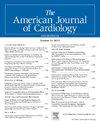老年心力衰竭患者使用葡萄糖共转运蛋白-2抑制剂钠的预测因素:现实世界人口水平数据集分析
IF 2.1
3区 医学
Q2 CARDIAC & CARDIOVASCULAR SYSTEMS
引用次数: 0
摘要
钠-葡萄糖共转运蛋白-2抑制剂(SGLT2i)已被证明对心力衰竭(HF)患者的心血管有强大的益处,但其实际应用的差异尚不清楚。我们的研究旨在评估SGLT2i处方的预测因素,并确定心衰患者的社会人口统计学差异。2017年1月至2022年6月,使用德克萨斯州医疗保险数据集进行了一项回顾性队列研究,以评估HF患者中SGLT2i处方相关因素。描述性统计用于比较各组之间的基线特征,多变量逻辑回归报告了SGLT2i处方的独立预测因子。对不同种族/族裔群体使用SGLT2i的调整边际概率进行估计。在309,577例HF患者中,与未服用SGLT2i的患者相比,服用SGLT2i的患者年龄≥80岁(16.9%对44%)、女性(45.7%对57.4%)和非西班牙裔白人(64.1%对75.1%)的可能性更小。糖尿病(aOR: 4.66, 95% CI: 4.45-4.87)、高血压(aOR: 1.09, 95% CI: 1.01-1.18)和肥胖(aOR: 1.35, 95% CI: 1.29-1.41)与较高的处方几率密切相关,而CKD III期和IV期、外周血管疾病和尿路感染与较低的处方几率密切相关。调整后的SGLT2i处方概率在亚洲人中最高(3.96%),在黑人中最低(2.26%)。总之,在HF患者中,SGLT2i处方存在显著差异,特别是在年龄、种族/民族和合并症负担方面。努力促进公平获得指南指导的药物治疗是必要的,以减少心衰护理的差异。本文章由计算机程序翻译,如有差异,请以英文原文为准。
Predictors of Sodium Glucose Co-Transporter-2 Inhibitor Utilization in Elderly Heart Failure Patients: A Real-World Population-Level Dataset Analysis
Sodium-glucose cotransporter-2 inhibitors (SGLT2i) have demonstrated robust cardiovascular benefits in patients with heart failure (HF), yet disparities in their real-world utilization remain unclear. Our study aims to evaluate predictors of SGLT2i prescription and identify sociodemographic disparities among HF patients. A retrospective cohort study was conducted using the Texas Medicare dataset between January 2017 and June 2022 to evaluate factors associated with SGLT2i prescription among HF patients. Descriptive statistics were used to compare baseline characteristics between groups, and multivariable logistic regression reported independent predictors of SGLT2i prescription. Adjusted marginal probabilities of SGLT2i use were estimated across racial/ethnic groups. Of 309,577 HF patients, those prescribed SGLT2i were less likely to be ≥80 years (16.9% vs 44%), female (45.7% vs 57.4%), and Non-Hispanic Whites (64.1% vs 75.1%) compared to those not prescribed SGLT2i. Diabetes (aOR: 4.66, 95% CI: 4.45–4.87), hypertension (aOR: 1.09, 95% CI: 1.01–1.18), and obesity (aOR: 1.35, 95% CI: 1.29–1.41) were strongly associated with higher odds of prescription, while CKD stage III and IV, peripheral vascular disease, and urinary tract infection were associated with significantly lower odds. Adjusted probability of SGLT2i prescription was highest among Asians (3.96%) and lowest among Blacks (2.26%). In conclusion, significant disparities exist in SGLT2i prescription among HF patients, particularly by age, race/ethnicity, and comorbidity burden. Efforts to promote equitable access to guideline-directed medical therapy are warranted to reduce disparities in HF care.
求助全文
通过发布文献求助,成功后即可免费获取论文全文。
去求助
来源期刊

American Journal of Cardiology
医学-心血管系统
CiteScore
4.00
自引率
3.60%
发文量
698
审稿时长
33 days
期刊介绍:
Published 24 times a year, The American Journal of Cardiology® is an independent journal designed for cardiovascular disease specialists and internists with a subspecialty in cardiology throughout the world. AJC is an independent, scientific, peer-reviewed journal of original articles that focus on the practical, clinical approach to the diagnosis and treatment of cardiovascular disease. AJC has one of the fastest acceptance to publication times in Cardiology. Features report on systemic hypertension, methodology, drugs, pacing, arrhythmia, preventive cardiology, congestive heart failure, valvular heart disease, congenital heart disease, and cardiomyopathy. Also included are editorials, readers'' comments, and symposia.
 求助内容:
求助内容: 应助结果提醒方式:
应助结果提醒方式:


